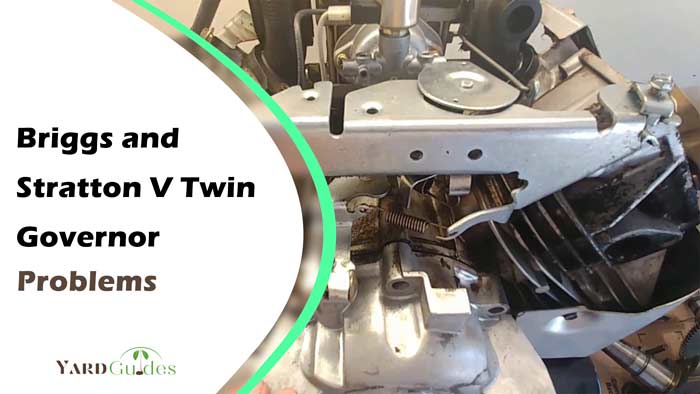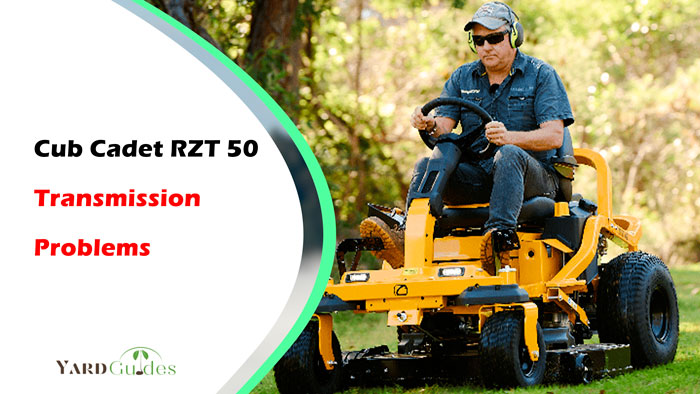The Briggs and Stratton V Twin Governor regulates the engine’s speed by controlling fuel and airflow into the engine. So, when it fails, you will have serious problems with your lawn mower.
So, what are the common Briggs and Stratton V Twin governor problems? They include-
- Hunting or surging
- Not maintaining a constant RPM
- Overspeeding or under-speeding
- Stalling or shutting off abruptly
- Gear failure, etc.
Additionally, the governor may not respond to changes in load or suffer from linkage binding or stretched springs.
This article will discuss the common Briggs and Stratton V Twin governor problems and provide solutions.
Here is a table illustrating the problems together with their respective solutions:
| No. | Problem | Solution |
| 1 | Hunting or surging | Clean or replace the air filter, adjust the carburetor |
| 2 | Not maintaining constant RPM | Adjust the governor linkage, check for binding or stretched spring |
| 3 | Engine over-speeding or under-speeding | Check the governor spring tension, adjust the linkage |
| 4 | Stalling or shutting off abruptly | Check for fuel or ignition issues |
| 5 | Governor gear failure | Replace the damaged gear |
| 6 | Governor spring or linkage issues | Replace the damaged spring or linkage |
| 7 | Governor oil seal leaking | Replace the damaged oil seal |
Briggs and Stratton V Twin Governor Problems and Step by Step Solutions
Here is a detailed discussion on the problems and solutions Briggs and Stratton V Twin Governor.
1. Hunting or Surging
Hunting or surging refers to the engine’s erratic speed fluctuations. This can frustrate the operator, leading to decreased performance and potential engine damage. This problem is caused by issues such as dirty carburetors, fuel system problems, or improper adjustment of the governor.
Solution
All you need to do is to make adjustments to the governor spring tension. This will fine-tune the engine’s performance and eliminate hunting or surging.
If that doesn’t work, it means the problem is caused by other culprits mentioned above. You might need to clean your Carburetor, air filter and fuel system.
Here is a video explaining how you can fix this problem visually:
2. Irregular RPM
With this problem, an engine will fail to maintain constant Revolutions Per Minute (RPM) or rotational speed. This issue can happen due to worn-out governor springs, linkage issues, or improper adjustments.
Solution
Adjust the governor to the proper settings. This adjustment will ensure that the engine is running at the correct RPM and prevent any further irregularities. Cleaning the air filter and fuel system can also improve engine performance and help prevent irregular RPM issues.
3. Engine Over-speeding or Under-speeding
Over-speeding occurs when the engine runs faster than intended. Under-speeding happens when the engine runs at a lower speed than intended. Governor gear failure, throttle cable problems, or carburetor issues cause this.
Solution
Assuming this problem is caused by governor gear failure alone, you will need to:
Step 1: Inspect it. Look for signs of wear or damage to the governor spring. The governor spring is a small spring that connects the throttle to the governor’s arm.
Step 2: If the spring is stretched or damaged, it can cause the engine to over-speed. So, try to repair it. If the stretching can’t be fixed, you are better off buying a new one.
If the above fixes nothing, it means your engine governor is okay and the culprits are the other causes mentioned. So, start by inspecting the throttle cable. Next, you will need to repair or rebuild the carburetor if it is damaged.
4. Stalling or Shutting off Abruptly
This problem occurs when the engine suddenly stops running on its own or after an external factor. The external factors could be hitting a bump and going up a hill.
Solution
To fix this issue, you need to adjust your engine governor arm to the sweet spot where your engine is operating efficiently. Use the steps below to do so:
Step 1: Locate the governor arm, typically located near the carburetor and connected to the throttle linkage.
Step 2: Loosen the nut that holds the governor arm to the shaft, then slide the arm off the shaft.
Step 3: Locate the governor shaft, usually near the flywheel. Inspect the shaft for wear or damage, and replace it if necessary.
Step 4: Adjust the governor arm by moving it in the direction of the shaft to increase engine speed or in the opposite direction to decrease engine speed. Adjust the arm in small increments to avoid overspeeding or under speeding the engine.
Step 5: Once the desired engine speed is achieved, tighten the nut on the governor arm shaft to secure it in place.
Step 6: Start the engine and let it run for a few minutes to ensure it is running at the proper speed. Adjust the governor arm again until the desired speed is achieved if necessary.
5. Governor Gear Failure
The governor gear controls the engine’s speed. Its failure can cause various issues, such as surging, over-speeding, or under-speeding. This issue can be caused by wear and tear, incorrect installation, or improper maintenance.
Solution
To fix the failure, you will need to replace or install your governor gear correctly. Follow the steps below:
Sep 1: Remove the engine cover: Using a socket wrench, remove the bolts that secure the engine cover to the engine. Then, lift the cover off the engine.
Step 2: Locate the governor gear: The governor gear is located near the flywheel and crankshaft at the bottom of the engine. It is connected to the governor assembly and helps regulate the engine speed.
Step 3: Inspect the governor gear: Check the governor gear for any signs of wear or damage. If the gear teeth are worn or broken, or if the gear is loose, it may need to be replaced. Also, check if it’s installed correctly and replace any missing components.
Step 4: Replace the governor gear: If the governor gear is damaged, it must be replaced. First, remove the cotter pin that secures the governor’s gear to the governor assembly.
Then, remove the governor gear from the crankshaft. Install the new governor gear in its place and secure it with a new cotter pin.
6. Spring or Linkage Issues
The governor spring and linkage control the engine’s speed. Any problems with these components can cause engine performance issues. You will have a problem maintaining your engine speed, accelerating, and performing tasks that need high engine power.
This issue is caused by improper alignment of governor components, binding, and wear and tear.
Solution
You have to replace damaged parts and align all components to the sweet spot where your engine is operating optimally. Follow the steps below:
Step 1: Inspect the spring and linkage: First, visually inspect the governor spring and linkage to identify any visible signs of wear, damage, or looseness.
Step 2: Replace any damaged parts: If you notice any damage, looseness, or excessive wear in the governor spring or linkage, you may need to replace these parts with new ones.
Step 3: Check governor arm alignment: Ensure the governor’s arm is aligned correctly and seated in its socket.
Step 4: Adjust the governor linkage: Adjust the governor linkage in small increments.
Step 5: Check for binding: Ensure that the governor linkage moves freely without any binding. If you detect any binding, you may need to replace the governor spring or linkage.
7. Oil Seal Leaking
The governor oil seal is responsible for keeping the oil inside the engine and preventing it from leaking. With a damaged seal, your oil will leak, causing hunting, surging, or overspeeding.
Damaged seals are a result of aging and deterioration due to long use, overuse and under-tightening. Exposure to high temperatures and toxic solvents might also lead to leaks.
Solution
A leaking seal needs to be tightened to the right torque. You should also check to see whether it is installed correctly. If you still have leaks, you will need to install new seals. So, start by turning off the engine and letting it cool down completely, then follow the steps below:
Step 1: Locate the governor’s oil seal. This is usually found on the bottom side of the engine near the crankshaft.
Step 2: Remove the belt guard covering the governor assembly if necessary.
Step 3: Remove the governor gear by loosening the bolt and holding it in place. Take note of its orientation for reassembly later.
Step 4: Use a seal puller or a flathead screwdriver to remove the governor oil seal from its housing. Be careful not to damage the housing or the crankshaft.
Step 5: Clean the housing and the surrounding area thoroughly with a rag or shop towel.
Step 6: Install the new governor oil seal in the housing, ensuring it is properly seated and flush with the housing. You can use a seal driver or a socket that fits over the seal to tap it in place evenly and gently.
Step 7: Reinstall the governor gear in the correct orientation and tighten the bolt to the torque specification outlined in the engine manual.
Step 8: Replace the belt guard covering the governor assembly, then start your engine to test if the issue has been fixed.
Conclusion
The Briggs and Stratton V-twin governor is a reliable piece of equipment for powering various applications, but it is not without its issues. Fortunately, proper maintenance and adjustments can address many of these Briggs and Stratton V-twin governor problems.
You should understand the underlying causes of these issues and take proactive measures to prevent them. This can go a long way in ensuring the long-term reliability and performance of your Briggs and Stratton V-twin engine.



